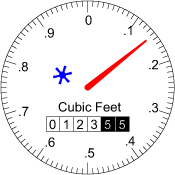If you have an unusually high Washington Water bill, you can conduct a water audit to see where the problem may be. To perform an audit, check the following:
- Is your water meter moving?
- Are there any dripping faucets? Thirty drips per minute adds up to approximately 15 gallons per day.
- Do you have a leaking toilet?
- Is there a leaking irrigation valve?
- Do you have a sprinkler system? If so, is it on a timer? Is the timer operating correctly?
- Were you gone for any number of days during the month in question? If so, did somebody take care of your plants or animals for you?
- Do you have a water softener? Is it the recycling type? Is it operating correctly?
- Do you have an under-the-sink filter system? Is it operating correctly?
- Does the handle on your toilet have to be jiggled to make the water stop running?
- Do you have a hot tub or pool? If so, have you adjusted the float arm lately?
- Did you have your fire sprinkler system maintained?
- Have you repaired any leaking faucets, water heaters, etc., lately?
- Is there a recycling hot water unit? Is it operating correctly?
- Are there any wet spots on the lawn or inside the home on walls, ceilings, etc.?
- If you are a commercial customer (restaurant, convenience store, etc.), do you have a purifying water machine, “serve yourself” machine, or soft drink machine that might need repair or have experience unusually high usage?
If you answered “yes” to any of these questions, then you may have found the source of your unusual water usage. Investigate further.
Check for Hidden Leaks

Make sure that water is not slipping away due to undetected leaks in your system. To check for household leaks, turn off the water inside and outside your home. Observe the test hand (depicted at right in blue); if it moves, there is water pushing through the meter, indicating a leak. To locate a leak, try:
- Looking for wet spots that could indicate a leak in the pipe between the meter and the home or the sprinkler system.
- Dropping a dye tablet in the toilet tank. Don’t flush. If colored water appears in the bowl, the toilet leaks.
- Using these indoor and outdoor tips to identify leaks.
Do you have a leaking toilet?
The most common culprit for indoor leaks is the toilet. To find out if your toilet leaks, listen for the sound of running water. You can also place a few drops of food coloring in the tank. Don’t flush the toilet. If the coloring is seen in the bowl, the toilet is leaking.
Once I’ve repaired household leaks, what other steps can I take to save money on my bill?
There are many things you can do to save water, both outside and inside your house.
Outside the house
- Water thoroughly but less frequently and only in the cool times of day.
- Turn off your automatic sprinklers when it rains.
- Water your lawn only when it needs it. If a screwdriver inserted into the soil goes in seven inches easily, the lawn doesn’t need water.
- Don’t let the hose run while washing your car; use a bucket instead with a quick hose rinse at the end.
- Use a broom instead of a hose to clean driveways and sidewalks.
Inside the house
- Run only full loads in your washing machine and dishwasher.
- Refrain from using your toilet as a wastebasket.
- Turn the water off while brushing your teeth and shaving.
- While waiting for hot water to come down the pipes, capture the cold water in a watering can to use later on your plants.
- Shorten your showers.
- Install a low-flow showerhead.


